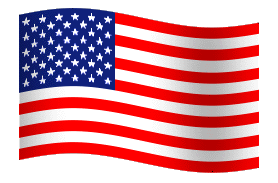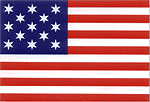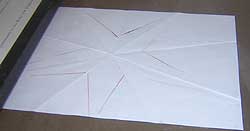
Betsy Ross and the American Flag
Historic Analysis
Betsy Ross is regarded by many as a character befitting a fable — that the tale of her making the first flag is no more than an instructive parable.
Modern-day parsers of the past suggest that several 19th-century authors and enthusiasts of American history were overanxious to champion the story of Betsy Ross brought to public attention by her grandson, William Canby, in a speech before the Pennsylvania Historical Society in 1870. That the story of the patriots of the Revolutionary Era required a deserving female role model. That magazines, textbooks, and artists uncritically have echoed the contrivance of a man who was an 11-year-old boy when his grandmother died. Some historians dismiss Canby's testimony and assertions entirely, viewing the absense of any written record of the flag's creation as more persuasive than an oral history
The testimony of Betsy Ross's daughter and other family members recount Betsy's story, and historically no other evidence has ever emerged to contradict that testimony or otherwise cast doubt on its veracity. Evaluating the circumstantial evidence also supports her story, including the paper star found in a safe in the 20th century. In April 2009, the Pennsylvania Historical and Museum Commission officially recognized Betsy Ross's contributions with a historic marker in front of her house, stating, "Credited with making the first stars and stripes flag, Ross was a successful upholsterer. She produced flags for the government for over 50 years. As a skilled artisan, Ross represents the many women who supported their families during the Revolution and early Republic."
The true story of Betsy's involvement with the American flag remains unclear and it's likely that it always will. The evidence is not definitive and conclusive, but it is persuasive. Curious minds are encouraged to look at primary sources, examine evidence firsthand, and draw their own conclusions, not just with regard to Betsy and the flag, but with all contentious subjects.
Primary Sources
- William Canby's Paper
- Affidavits of Betsy Ross's daughter, granddaughter, and niece
This page comprises four sections.
The first is how Betsy Ross's deeds were brought to the public's attention.
The second part is set up as a point-counterpoint with arguments and rebuttals.
The third sets forth points in support of Betsy Ross having sewn the first flag.
The fourth shows printed examples of how her story is being told by widely distributed sources, followed by our comments.
Part 1: Betsy's Deeds Are Made Public
In March 1870, in anticipation of America's Centennial, William Canby, a grandson of Betsy Ross, made public the story of Washington's visit to the flagmaker. In a paper given to the Pennsylvania Historical Society, the justifiably proud grandson related to the world his grandmother's deeds.
Since Canby was a mere lad of 11 when Betsy passed on in 1836, he relied on his own recollections as well as those of other relatives. For the record, three affidavits were sworn to, one by a daughter of Betsy Ross, one by a granddaughter, and one by a niece. These statements communicate in clear detail that Betsy Ross often told them the heroic saga of the birth of the American flag.
Canby's paper recounts a meeting between a secret Congressional Committee and the widowed seamstress. The committee of Robert Morris and George Ross was accompanied by George Washington. The meeting resulted in the creation of the first American flag. Betsy contributed by suggesting a 5-pointed star, rather than the 6-pointed star recommended by Washington.
After Canby's lecture, the story of Betsy and the flag took root in the hearts of Americans. Harper's Monthly retold the story in a July 1873 issue. In the 1880s, the story began to appear in textbooks. Charles Weisgerber's painting "Birth of Our Nation's Flag" (a detail of which is displayed on the homepage) was exhibited with admiration at the 1893 World Columbian Exposition in Chicago.
Part 2: Point-Counterpoint
Some have suggested that Canby invented the story out of whole cloth to bring himself fame. Others suggest that an 11-year-old boy's memory of Grandma's stories cannot be trusted. The sworn testimony of Betsy's daughter and other descendants, as well as Canby's own memory make very clear that the source of the stories are Betsy Ross's own words. Did Betsy, a known flagmaker, embellish the truth by saying she made the first one?

"Hopkinson flag"
In a letter submitted to the Board of Admiralty in 1780, Hopkinson sought payment for his design of "the flag of the United States of America" as well as several ornaments, devices, and checks appearing on bills of exchange, ship papers, the seals of the boards of Admiralty and Treasury, and the Great Seal of the United States. The invoice was rejected because it lacked vouchers. On resubmitting his invoices, he changed the reference from "the flag of the United States of America" to now state, "The Great Naval Flag of the United States." There is no historical record of what his flag looked like.
The price he affixed to his design was one of the higher ones among those in the voucher, indicating a far more intricate and complex design than the relatively simple American flag. It would seem that Hopkinson's flag was not our Stars and Stripes.
Looking at the number of points on the stars, we note that Hopkinson, at that time, designed with 6-pointed stars. Hopkinson's family coat of arms contained 6-pointed stars. Washington's Commander-In-Chief flag had 6-pointed white stars in a blue field. Hopkinson's work, before and after 1776, favored the 6-pointed star. 5-pointed stars don't appear in Hopkinson's designs until years later. It's unlikely that he would use 6-pointed stars, suddenly switch to a 5-pointed star for exactly one flag, then continue designing with 6-pointed stars for years before finally switching to the 5-pointed star for his later designs.
Apart from the voucher, which unlikely refers to the flag with 5-pointed stars in a circular pattern, or any relatively simple stars and stripes design, there is absolutely no evidence in support of his designing the flag.
For those who are curious, though it is irrelevant to this discussion, Hopkinson's entire set of invoices was rejected.
Part 3: Points in Support of Betsy
In addition to the family testimony, there are fascinating if inconclusive arguments in favor of Betsy sewing the first flag.
POINT: The Artistic Argument
One of the arguments used against Betsy Ross is the timeline. The following show that her Stars and Stripes was in use on the battlefield well before the flag resolution of June 14, 1777.
Colonel John Trumbull and Captain Charles Willson Peale were artists who fought under George Washington. Today they are both acknowledged as preeminent artists of their day.
Peale led a group of foot soldiers at the Battle of Princeton under the great General. The battle took place on January 3, 1777, five months before the flag resolution — the first historically acknowledged reference to the Stars and Stripes. "Washington at the Battle of Princeton" was a series of paintings Peale executed between 1778 and 1781. In one of them, the viewer can see the left side of a flag containing a blue field with a circle of 13 white stars, as well as a number of captured Hessian flags which are at Washington's feet. Peale cared greatly about accuracy in his paintings and specifically had the Hessian flags brought to his studio to be painted. Some historians dismiss the American flag in this painting as anachronistic — a claim we find unbelievable and inexplicable in light of the care for accuracy Peale is known to have shown, according to Peale's biographers. That painting can be seen today at the Pennsylvania Academy of Fine Arts in Philadelphia. Another painting depicting the Battle of Princeton, done for Princeton University (and still on display there), again shows the Stars and Stripes, as well as Washington's Headquarters flag, on the battlefield.
Trumbull became an aide to Washington and served at both the Battle of Trenton (December 25, 1776) and the Battle of Princeton. Several of his paintings also show the Stars and Stripes on the battlefield with Washington.
POINT: Wetherill and his Safe
 Betsy star previously on display at the Free Quaker Meeting House, Philadelphia. It has since gone missing.
Betsy star previously on display at the Free Quaker Meeting House, Philadelphia. It has since gone missing.Samuel Wetherill was a good friend of Betsy Ross. In fact he and Ross were the last two members of the Free Quaker Meeting House and together shut its doors for the last time in 1834. The Wetherill family oral tradition holds that he visited Betsy shortly after her meeting with the Congressional Committee. She told him what had just transpired.
Wetherill, recognizing the historic import of that meeting, asked if he could keep the 5-pointed star which Ross had cut for the committee. She gave it to him. In 1925, the Wetherill family safe was opened and inside was that 5-pointed star. Until recently, that star was exhibited at the Free Quaker Meeting House, a few blocks from the Betsy Ross House. It has since gone missing.
Part 4: Published Accounts
"Though she (Betsy) was long believed to have designed the American flag, this claim has now been disproved..." SOURCE: Philadelphia Access, Access Press, New York, 1993
OUR REPLY: It has not been disproved. It has simply not been proved, and likely will never be. However, with the Hopkinson story so much in doubt, we must encourage future generations of historians to continue researching this question.
"And while historians negate the possibility that Betsy Ross made the first Stars and Stripes..." SOURCE: "The Stars and the Stripes: The American Flag as Art and as History from the Birth of the Republic to the Present" by Boleslaw and Marie-Louise D'Otrange Mastai, Alfred Knopf, New York, 1973
OUR REPLY: Cite your sources. Which historians are you referring to who actually negate the possibility?
"...there could certainly be no very logical reason for replacing the Great or Grand Union Flag with a national banner of new design." SOURCE: "The History of the United States Flag" by Milo M. Quaife, Melvin J. Weig, and Roy E. Appleman, Harper and Row, New York, Evanston, and London, 1961
OUR REPLY: Confusion with a flag of surrender would be very logical. See earlier on this page.
In summary
Historically, the story of Betsy Ross remains unresolved. She was familiar to Washington and to George Ross, her husband's uncle, and the testimony of her decendents is consistent with the facts we do have.
Is her story a fiction, a partial truth, completely true? We may never know for sure, but we do hope future historians can shed additional light on this unresolved question.


